Author :
Abstract
Bu çalışmada Yûnus Emre Divanı’nın Bursa Nüshası ele alınıp söz varlığında yer alan denk çiftler ortaya konacaktır. Seçilen kelimelerin Batı Türkçesindeki gelişimi göz önünde bulundurularak Eski Anadolu Türkçesinde, Yûnus Emre Divanı’nın Bursa Nüshası’nda ve Türkiye Türkçesi yazı dilindeki kullanımları karşılaştırmalı olarak verilecektir. Divan’daki denk çift sayısından yola çıkılarak Eski Anadolu Türkçesi ve Batı Türkçesine yakınlığı açısından bir değerlendirme yapılacak, divanda denk çiftlerin bulunmasının nasıl yorumlanabileceği üzerinde durulacaktır. Elde edilen sonuçlar divandaki beyit numaraları ve kullanım sıklıkları ile birlikte tablolar halinde de sunulacaktır. Bu şekilde eserin günümüz yazı diliyle olan ilişkisi de belirlenebilecektir.
Keywords
Abstract
When the language of historical texts is examined, words that are seen as characteristic in different dialects today and expressed as equivalent pairs are seen. Old Anatolian Turkish is a period in which equivalent couples are used frequently and together. (bul-/tap-, benze-/ohşa-, gece/dün, gibi/tek, kaç/neçe, kendü/öz, ört-/yap-, elig/kol, dal/budak, kemik/sünük )These words appear in these texts as equivalent pairs. In this study, the Bursa Copy of Yunus Emre's Divan will be handled and the equivalent pairs in the vocabulary will be revealed. Selected in the words of the old West Anatolian Turkish Considering the developments in Turkish, Yunus Emre use in Nüshası Board of Bursa and Turkey in Turkish literary language will be comparatively. Based on the number of equivalent pairs in the Divan, an evaluation will be made in terms of proximity to Old Anatolian Turkish and Western Turkish, and how to interpret the presence of equivalent pairs on the sofa will be discussed. The results obtained will also be presented in tables together with the couplet numbers on the sofa and their usage frequency. In this way, it will be possible to determine the relation of the work with today's written language
Keywords
- Dinçer Bahadır, Şaziye, (2015), “Risâletü’n Nushiyye’de Bağlama Bağlı Yakın Anlamlı Çiftler”, Atatürk Üniversitesi Türkiyat Araştırmaları Enstitüsü Dergisi.
- Doğan, İsmail; Usta, Zerrin, (2014), Eski Uygur Türkçesi Söz Varlığı, Altınpost Yayınları, Ankara.
- Gabain, Annamaria, (1988), Eski Türkçenin Grameri, Türk Dil Kurumu Yayınları, Ankara.
- Gül, Meltem, (2015), “Kutadgu Bilig’deki Oğuzca Unsurlar”, The Journal of Academic Social Science Studies, s.253.
- Gülsevin, Gürer, (2007), “Kutadgu Bilig’in Dilinde Lehçelerin Özellikleri: ‘denk çiftler’, Turkish Studies/ Türkoloji Araştırmaları, Volume 2/2 Spring.
- Kanar, Mehmet, (2011), Eski Anadolu Türkçesi Sözlüğü, Say Yayınları, İstanbul.
- Komisyon, (1992), Karşılaştırmalı Türk Lehçeleri Sözlüğü I, Kültür Bakanlığı Kaynak Eserler,
- Kuybu, Ebru, (2015), Yûnus Emre Dîvanı’nın Bursa Nüshası (Giriş-Metin-Dil İncelemesi- Dizin), Uludağ Üniversitesi Sosyal Bilimler Enstitüsü Yüksek Lisans Tezi, Bursa.
- Şahin, Hatice, (2006), Eski Anadolu Türkçesi, Akçağ Yayınları, Ankara.
- Uysal, İdris Nebi, (2014), Yunus Emre Dîvanı (Karaman Nüshası), Kesit Yayınları, İstanbul.





